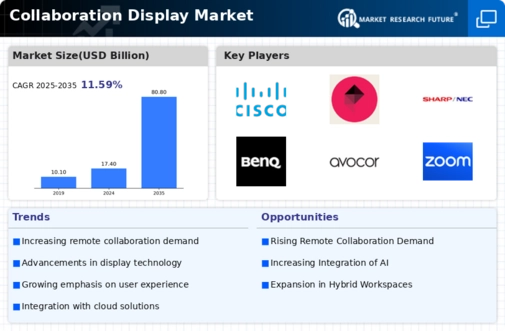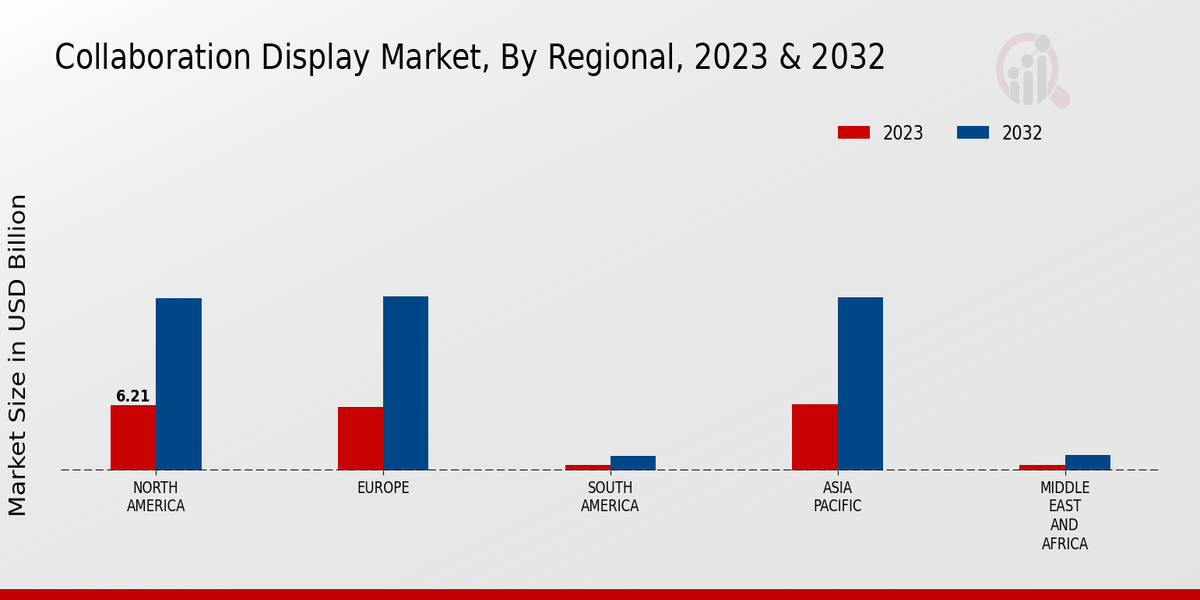Market Growth Projections
The Global Collaboration Display Market Industry is poised for remarkable growth, with projections indicating a market size of 17.4 USD Billion in 2024 and an anticipated increase to 80.8 USD Billion by 2035. This growth trajectory suggests a compound annual growth rate of 14.97% from 2025 to 2035, reflecting the increasing reliance on collaborative technologies in various sectors. The market's expansion is driven by factors such as technological advancements, the rise of remote work, and the globalization of business operations. These dynamics highlight the evolving landscape of collaboration tools and their integral role in modern organizational strategies.
Globalization of Business Operations
The globalization of business operations is a significant driver of the Global Collaboration Display Market Industry. As companies expand their reach across borders, the need for effective communication and collaboration tools becomes increasingly critical. Collaboration displays facilitate real-time interaction among geographically dispersed teams, enabling organizations to maintain productivity and cohesion. This trend is particularly evident in multinational corporations that require consistent communication across various time zones. The market's growth is indicative of this need, as businesses invest in technology that supports their global operations and enhances their competitive edge in an interconnected world.
Increased Focus on Employee Engagement
The Global Collaboration Display Market Industry is significantly influenced by the heightened focus on employee engagement and collaboration. Organizations recognize that fostering a collaborative culture enhances creativity and innovation, leading to improved business outcomes. Collaboration displays serve as vital tools in this endeavor, providing interactive environments that encourage participation and idea sharing. As companies strive to create more inclusive workplaces, the demand for these displays is likely to increase. This trend aligns with the projected compound annual growth rate of 14.97% for the period from 2025 to 2035, indicating a robust market trajectory driven by the need for enhanced employee engagement.
Growing Adoption of Smart Office Solutions
The growing adoption of smart office solutions is reshaping the Global Collaboration Display Market Industry. Organizations are increasingly integrating advanced technologies into their workspaces to create more efficient and productive environments. Collaboration displays are central to this transformation, offering features that support connectivity, automation, and data sharing. As businesses seek to optimize their operations and enhance employee experiences, the demand for smart office solutions, including collaboration displays, is expected to rise. This trend underscores the importance of technology in modern workplaces, driving the market towards substantial growth in the coming years.
Rising Demand for Remote Collaboration Tools
The Global Collaboration Display Market Industry experiences a surge in demand for remote collaboration tools, driven by the increasing need for effective communication in distributed teams. As organizations adopt hybrid work models, the necessity for technology that facilitates seamless interaction becomes paramount. In 2024, the market is projected to reach 17.4 USD Billion, reflecting the growing reliance on digital solutions. Companies are investing in collaboration displays to enhance productivity and engagement among remote workers. This trend indicates a shift towards integrated platforms that combine video conferencing, screen sharing, and interactive displays, thereby fostering a more collaborative environment.
Technological Advancements in Display Solutions
Technological advancements play a crucial role in shaping the Global Collaboration Display Market Industry. Innovations such as high-resolution displays, touch interactivity, and artificial intelligence integration enhance user experience and functionality. These advancements enable more dynamic presentations and collaborative sessions, making them appealing to businesses seeking to improve their operational efficiency. The introduction of features like wireless connectivity and cloud integration further supports this trend. As organizations increasingly prioritize technology that can adapt to their evolving needs, the market is expected to grow significantly, with projections indicating a rise to 80.8 USD Billion by 2035.























Leave a Comment